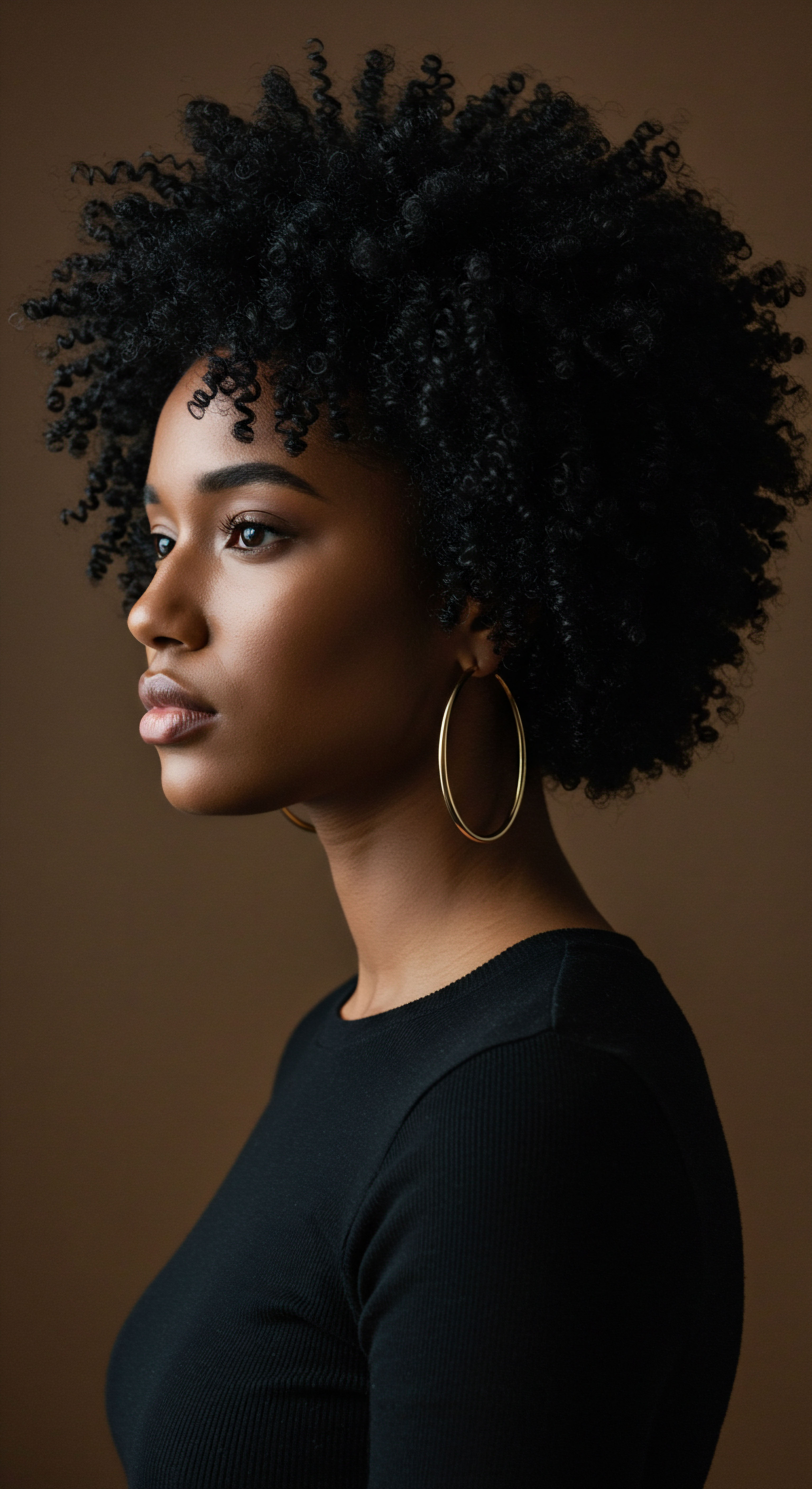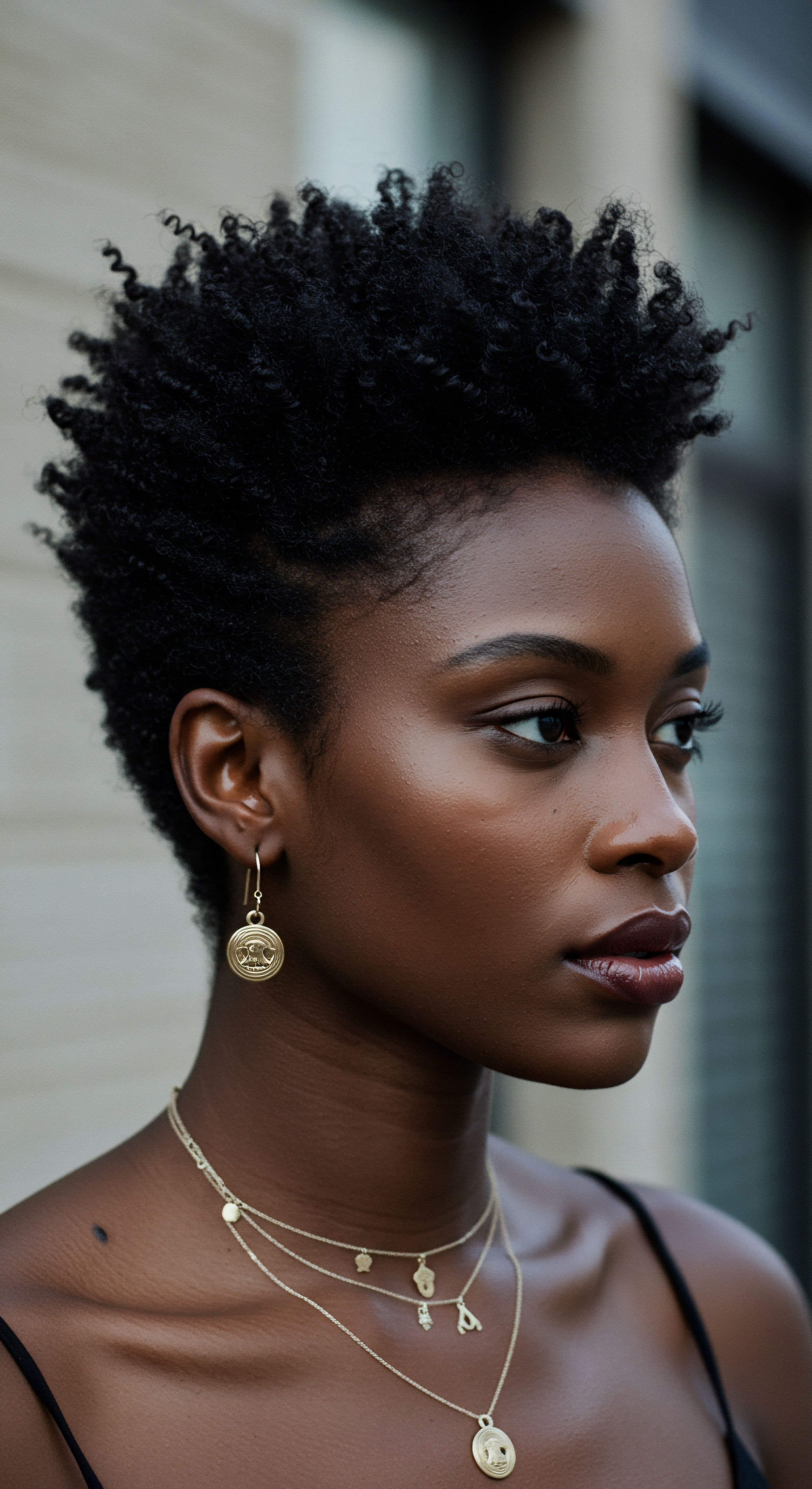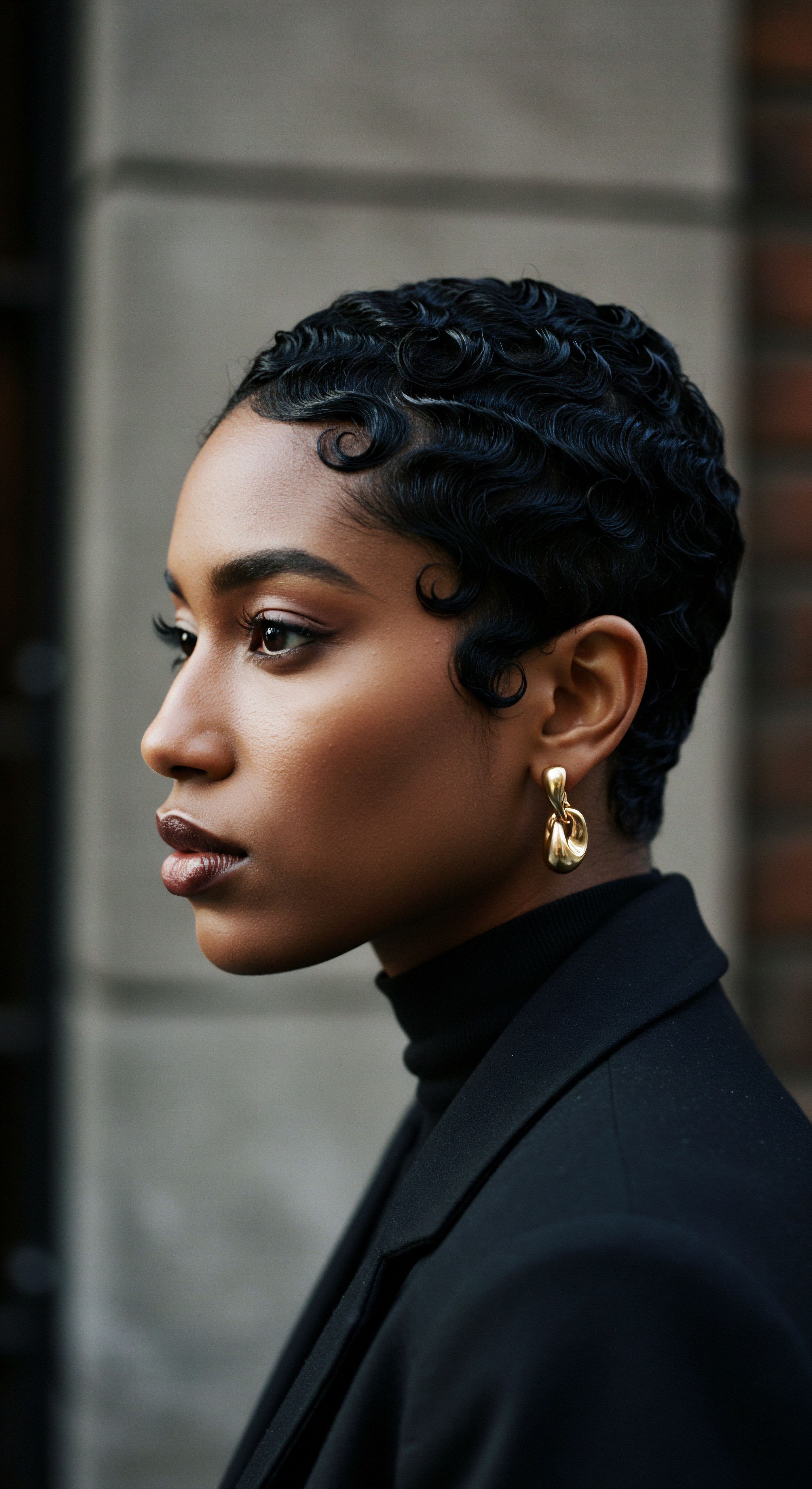
Roots
Consider the subtle shift in the morning light, how it awakens the world around us. In much the same way, a quiet awakening unfolded across ancient lands, shaping something as intimate as our hair care. Long before our modern understanding of hair science, before the array of products lining today’s shelves, early communities looked to their immediate surroundings for answers to hair health and adornment.
Yet, the reach of their care extended far beyond the local riverbank or forest edge. The very earth, with its diverse bounty, offered up its secrets, and as societies began to connect, these secrets traveled.
The origins of hair care practices are deeply rooted in humanity’s early relationship with nature. From the earliest moments, individuals sought ways to cleanse, protect, and beautify their strands. This quest was not merely aesthetic; it was bound to health, status, and spiritual connection. Think of the simplest elements ❉ water, natural oils, and clays.
These formed the bedrock of early hair regimens. As human settlements grew and interactions broadened, the exchange of these foundational materials began to influence local practices, subtly reshaping what was possible for hair.

Early Materials and Their Local Origins
Across ancient civilizations, the initial palette for hair care was drawn directly from the immediate environment. In ancient Egypt, for instance, the use of Castor Oil was a staple, celebrated for its conditioning and strengthening properties. This thick oil, often mixed with honey and other herbs, formed masks to promote growth and add shine.
Similarly, in Mediterranean cultures, Olive Oil held a revered place, employed to smooth hair, prevent frizz, and impart a healthy sheen. These local resources served as the initial foundation, a testament to ingenious adaptation to what was readily available.
Beyond oils, early communities utilized various plant extracts and clays for cleansing. In Mesopotamia and Egypt, individuals discovered the cleansing properties of specific plants and mineral-rich clays. These early innovators set the stage for traditions that still resonate today.
For example, in the Philippines, the bark of the Gugo Vine (Entada phaseoloides) has been used for centuries as a natural shampoo, producing a soap-like foam due to its saponin content, offering both cleansing and medicinal benefits for the scalp. Such practices, born of local flora, represent the earliest expressions of hair care wisdom.

The Dawn of Hair Tools and Adornment
Alongside natural ingredients, the creation of rudimentary tools marked a significant step in hair care evolution. Combs, often crafted from ivory or bone, stand as some of the oldest hair accessories found by archaeologists. Dating back as early as 3900 BCE in women’s tombs, these combs sometimes featured elaborate animal motifs, hinting at their ceremonial or symbolic importance. These early tools, though simple, enabled more intricate styling and better management of hair, moving beyond mere functionality to expressions of personal and communal identity.
Adornments also played a significant role. In ancient Egypt, gold wig rings and elaborate hairpieces were discovered in tombs, indicating a high level of sophistication in hair styling and personal presentation even in the afterlife. These items, initially local creations, would eventually become part of broader exchange networks.
The earliest whispers of hair care began with local flora and ingenious tools, deeply rooted in the natural world.

Initial Pathways of Exchange
While the grand trade routes we often discuss developed later, early forms of exchange were already at play, albeit on a smaller scale. Neighboring communities might exchange unique herbs, special clays, or even specific animal fats known for their hair-benefiting properties. These initial pathways, perhaps short distances between villages or tribal groups, laid the groundwork for the more expansive networks that would follow. The desire for novel scents, richer colors, or more effective cleansers fueled this early commerce, setting a precedent for the global movement of hair care ingredients.
Even within a single region, varied ecosystems offered different natural resources. A community near a desert oasis might possess certain rare oils, while another nestled by a river might have access to unique cleansing clays. The simple act of bartering these items introduced new possibilities for hair care, allowing practices to adapt and diversify beyond what any single locale could provide. This nascent exchange demonstrated an early understanding that a wider array of materials could enhance existing beauty rituals.

Ritual
Stepping beyond the quiet origins, we arrive at a space where daily care transforms into purposeful ritual, where the application of a balm or the sculpting of a style becomes a deliberate act of well-being and identity. This shift from simple practice to structured ritual is where the influence of ancient trade routes truly begins to shine. As distant lands connected, a kaleidoscope of new ingredients, tools, and ideas flowed across continents, enriching existing customs and inspiring entirely new ones. The pursuit of hair health and beauty was no longer confined to local bounty; it stretched across deserts and seas, carried by caravans and ships.
The movement of goods along ancient trade routes like the Silk Road, the Incense Route, and trans-Saharan networks brought forth a revolution in hair care. Suddenly, a woman in Rome could color her hair with henna from distant lands, or an Egyptian noble could scent her wig with oils from Arabia. These exchanges were not merely transactional; they were cultural dialogues, where techniques and philosophies of hair care were shared, adapted, and sometimes, entirely reinvented.

The Alchemy of Imported Ingredients
Ancient trade routes acted as conduits for ingredients that revolutionized hair care. Henna, derived from the Lawsonia inermis plant, serves as a prime example. Originating in North Africa, the Middle East, and India, henna was widely used in ancient Egypt to soften and thicken hair, and for coloring purposes. Its popularity spread, traveling along trade networks, allowing diverse cultures to incorporate its vibrant reddish-brown hues and conditioning properties into their hair rituals.
The Incense Route, a 2,000-kilometer network, transported valuable resins like Frankincense and Myrrh from southern Arabia and northeastern Africa to the Mediterranean. While primarily used for embalming, medicine, and religious ceremonies, these fragrant resins also found their way into cosmetics, enriching skin and hair preparations with their aromatic qualities. The demand for such exotic materials was so strong that they were sometimes priced higher than gold, underscoring their perceived value in ancient beauty and ritual.
Consider the sophistication of ancient hair gels. In ancient Egypt, evidence from mummies, some dating back 3,500 years, reveals hair styled with gels made from Palm Oils and Animal Fats. A particularly striking example is the Clonycavan Man, an Iron Age bog body from Ireland, whose distinctive quiff was held in place with a gel made from plant oils and pine resin imported from south-western France or northern Spain. This demonstrates that the international trade in hair products was well-established over two millennia ago, showcasing the lengths people would go to for desired styles.

How Did Trade Routes Shape Ancient Hair Coloring Practices?
The desire for varied hair colors spurred significant trade in natural dyes. Beyond henna, the Romans, who prized blonde or red hair, utilized a range of vegetable and animal substances for coloring. Black hair, often imported from India, was popular in Rome, and blonde hair from Germany was also highly sought after, sometimes acquired as spoils of war in the early Imperial period. This exchange of human hair for wigs and extensions highlights a direct, tangible influence of trade on hair aesthetics.
The movement of mineral pigments also played a role. While direct evidence for hair coloring with minerals through trade is less documented than for skin cosmetics, the broader exchange of materials like red ochre from Belgium for Roman blushes suggests a similar potential for hair applications. The widespread use of kohl, an antimony-based black paint with roots in North Africa, for eye lining across the Near East, indicates a network for cosmetic ingredients that could easily extend to hair dyes.
Trade routes transformed hair care, introducing exotic ingredients and advanced techniques that shaped beauty rituals across civilizations.
The practice of coloring hair was common across several social classes in ancient Rome, reflecting a widespread desire for specific shades. This demand propelled the commerce of ingredients, whether locally sourced or brought from distant lands.

Tools and Techniques on the Move
Beyond ingredients, trade routes facilitated the dissemination of tools and techniques. Specialized workshops in ancient Egypt produced wigs and extensions, utilizing tools like hairpins, combs, and bronze implements for waving and trimming. The very materials for these wigs, including human hair, were acquired through trade, often ranking alongside gold and incense in ancient accounts.
The Silk Road, famed for its textile commerce, also carried the influence of silk itself into hair care. In East Asian cultures, particularly China and Japan, Silk Hair Wraps became integral for protecting hair, maintaining elaborate hairstyles, and signifying social status. The secrets of silk production, initially guarded by China, spread along these routes, allowing silk fabrics to become symbols of wealth and sophistication in European and African hair traditions. In West Africa, silk was imported via trans-Saharan trade routes and used by the elite for hair wraps like the “gele” in Nigeria and “duku” in Ghana, reflecting cultural heritage and personal style.
| Ingredient Henna |
| Primary Origin North Africa, Middle East, India |
| Notable Ancient Users Egyptians, Romans, various Middle Eastern cultures |
| Associated Trade Routes Mediterranean trade routes, Incense Route |
| Ingredient Frankincense & Myrrh |
| Primary Origin Southern Arabia, Northeastern Africa |
| Notable Ancient Users Egyptians, Romans, various Middle Eastern cultures |
| Associated Trade Routes Incense Route |
| Ingredient Castor Oil |
| Primary Origin Ancient Egypt |
| Notable Ancient Users Egyptians |
| Associated Trade Routes Local trade, early Nile River routes |
| Ingredient Olive Oil |
| Primary Origin Mediterranean Basin |
| Notable Ancient Users Greeks, Romans |
| Associated Trade Routes Mediterranean maritime routes |
| Ingredient Pine Resin |
| Primary Origin South-western France, Northern Spain |
| Notable Ancient Users Iron Age Ireland (Clonycavan Man) |
| Associated Trade Routes Early European land routes |
| Ingredient Silk |
| Primary Origin China |
| Notable Ancient Users East Asians, Europeans, West Africans |
| Associated Trade Routes Silk Road, Maritime Silk Road, Trans-Saharan routes |
| Ingredient Human Hair (for wigs) |
| Primary Origin India, Germany, various regions |
| Notable Ancient Users Egyptians, Romans |
| Associated Trade Routes Mediterranean trade routes, European land routes |
| Ingredient This table shows how various natural substances and materials traveled across ancient networks, becoming central to hair care practices in distant lands. |

Relay
As we delve deeper into the interplay of ancient trade and hair care, we begin to perceive a sophisticated exchange, far beyond mere commerce. It is a relay of ideas, scientific understanding, and cultural meaning that shaped not only how hair was treated but also its societal significance. This section explores the profound, sometimes subtle, ways these ancient connections reshaped beauty standards, influenced genetic adaptations, and even served as conduits for resistance. The influence extends into the very understanding of hair as a biological and cultural marker.
The complex dynamics of ancient trade routes, from the Silk Road to the transatlantic networks, facilitated not just goods but also the flow of intangible assets ❉ knowledge, beliefs, and practices. This cultural dialogue had a tangible impact on hair care, pushing boundaries of available ingredients, refining existing techniques, and introducing entirely new aesthetic and protective approaches.

Did Trade Routes Influence Hair Texture Adaptations?
The movement of populations along ancient trade routes, often driven by commerce, migration, or conflict, played a role in the distribution and mixing of genetic traits, including those related to hair texture. While hair texture is primarily determined by genetics, environmental pressures and migration over millennia can influence the prevalence of certain traits within populations. For instance, tightly coiled hair, characteristic of many African populations, offers superior protection against intense solar radiation and heat, while also helping to preserve scalp moisture. As early human migrations and later trade networks facilitated movement across diverse climates, the adaptive advantages of different hair textures likely played a subtle, long-term role in their distribution.
A compelling, if sometimes overlooked, aspect involves the transatlantic slave trade. This brutal system, while not a “trade route” in the conventional sense of mutual exchange, was a forced migration that profoundly impacted hair care practices and perceptions for people of African descent. Enslaved Africans, stripped of their traditional tools and ingredients, had to innovate with what was available, using substances like kerosene, bacon grease, or butter to maintain their hair. Simultaneously, within this oppressive system, hair became a powerful symbol of resistance and communication.
Cornrows, a style deeply rooted in ancient African traditions, were ingeniously used by enslaved people to create secret maps and messages, indicating escape routes or safe houses along the Underground Railroad. They also concealed small tools or seeds for survival. This transformation of a beauty practice into a covert communication system highlights the resilience and adaptability of human hair care in the face of immense adversity, a direct, if tragic, consequence of a historical trade route.
Ancient trade routes not only transported ingredients but also facilitated the subtle shifts in hair care that shaped human adaptation and cultural expression.

The Scientific Underpinnings of Ancient Ingredients
Modern scientific understanding often validates the wisdom of ancient hair care practices. The plant extracts and oils exchanged along ancient routes possessed genuine properties beneficial for hair and scalp health. For example, Saponins, the compounds responsible for the soap-like foam in Gugo bark, also possess anti-inflammatory and antibacterial medicinal properties. This explains its effectiveness in treating dandruff and head lice, issues prevalent in all historical periods.
Similarly, oils like Olive Oil, widely traded across the Mediterranean, are rich in monounsaturated fats and antioxidants, providing nourishment to the scalp and preventing dryness. Coconut Oil, prominent in Ayurvedic practices from India and distributed via maritime trade, is known for its moisturizing properties and ability to enhance hair health. These ancient choices were not arbitrary; they were rooted in empirical observation and a practical understanding of natural chemistry, a knowledge base that expanded with increased inter-regional commerce.
The systematic study of these traditional ingredients reveals a sophisticated, if unwritten, science at play. For instance, the use of Rosemary and Peppermint Essential Oils, which likely traveled along various routes, is now supported by research showing their ability to stimulate blood circulation to the scalp, promoting hair growth and fortifying strands. The efficacy of these botanical elements, once discovered locally, was then amplified and disseminated through the networks of trade, allowing a wider population to benefit from their natural properties.

Cultural Exchange and Hair as Identity
Hair has always been a powerful marker of identity, signifying social status, age, gender, and tribal affiliation. Trade routes, by bringing diverse cultures into contact, fostered a dynamic exchange of styling techniques and aesthetic ideals. In ancient Rome, for example, the desire for blonde hair led to the importation of hair from Germany for wigs, alongside darker hair from India. This not only reflected a shift in beauty standards but also underscored the economic significance of human hair as a traded commodity.
The elaborate hair braiding traditions of Africa, such as Fulani Braids and Bantu Knots, carried deep cultural meanings, indicating wealth, marital status, or community roles. As African populations interacted with other cultures through various trade networks, elements of these styles or the adornments used (like beads and cowrie shells, which themselves were traded goods) could have been observed and adapted, even if the core meaning remained rooted in African heritage. This exchange was not always one-way; often, it was a complex interplay of influence and adaptation.
Consider the global impact of ancient combs. Archaeological finds in places like Ipswich, England, reveal combs imported from western continental Europe and southern Scandinavia during the Viking Age. These tools, essential for detangling and styling, represent a tangible cultural exchange facilitated by maritime trade routes. The presence of such artifacts speaks to a shared human desire for well-groomed hair, transcending geographical and cultural boundaries through the pathways of commerce.
The concept of hair as a canvas for self-expression, evident in elaborate ancient Egyptian wigs or Roman hairstyles, was amplified by the availability of new materials and techniques via trade. The ability to acquire exotic dyes, rare oils, or even human hair from distant lands meant that expressions of identity through hair could become more diverse and sophisticated, reflecting the cosmopolitan nature of interconnected ancient societies.
- Wig Hair ❉ Ancient Egyptians traded human hair for wigs, often ranking it alongside gold and incense in accounts.
- Pine Resin ❉ An Iron Age bog body from Ireland used pine resin, imported from France or Spain, as hair gel.
- Red Ochre ❉ Imported from Belgium, red ochre was used by Romans for cosmetics, potentially extending to hair dyes.
| Culture Ancient Egypt |
| Hair as a Symbol Social status, gender, religious purity, life stages |
| Trade Influence on Symbolism Imported hair for wigs and extensions; exotic oils for scenting |
| Culture Ancient Rome |
| Hair as a Symbol Wealth, social status, femininity, modesty |
| Trade Influence on Symbolism Imported blonde hair from Germany, black hair from India for wigs; dyes from various sources |
| Culture African Societies |
| Hair as a Symbol Tribal affiliation, age, marital status, social rank, communication |
| Trade Influence on Symbolism Imported silk for headwraps; trade in beads and cowrie shells for adornment |
| Culture Ancient India (Ayurveda) |
| Hair as a Symbol Holistic health, spiritual balance |
| Trade Influence on Symbolism Exchange of specific herbs (Amla, Shikakai, Neem) and oils (coconut, sesame) |
| Culture Hair's meaning was deeply intertwined with societal structures, with trade routes often amplifying or altering these cultural expressions. |

Reflection
The journey through ancient trade routes and their influence on hair care practices reveals a profound truth ❉ human ingenuity, coupled with an innate desire for beauty and well-being, has always found ways to connect and evolve. From the earliest use of local botanicals to the complex networks that transported exotic resins and human hair across continents, each interaction left an indelible mark. The whispers of distant lands, carried by merchants and caravans, brought forth new ingredients, refined techniques, and shifted cultural perceptions of hair itself. What began as simple adornment transformed into a sophisticated language of identity, status, and even covert communication, a testament to the enduring power of human connection and the universal desire to care for our crowning glory.

References
- Clark, Christine. The Global History of Cosmetics. Cambridge University Press, 2024.
- Smith, Penny. Hair ❉ A Cultural History. Berg Publishers, 2007.
- Williams, Elizabeth. A Cultural History of Hair. Bloomsbury Academic, 2018.
- Fletcher, Joann. Ancient Egyptian Hair and Cosmetics. British Museum Press, 1999.
- Hansen, Valerie. The Silk Road ❉ A New History. Oxford University Press, 2012.
- Czarra, Fred. Spices ❉ A Global History. Reaktion Books, 2009.
- Speidel, Michael. The Ancient Roman Army. Yale University Press, 1990.
- Riefstahl, Elizabeth. Ancient Egyptian Hairdressers. Brooklyn Museum Journal, 1952.
- Tassie, Geoffrey J. The Archaeology of Ancient Egypt. Routledge, 2014.
- Pollini, John. Gems of the Roman Empire ❉ The Glyptic Art of the Augustan Age. Cambridge University Press, 2015.
- Kohl, Philip L. The Bronze Age of the Near East and Central Asia. Ashgate Publishing, 2007.
- Frank, R. M. Ancient Egyptian Hair and Cosmetics ❉ A Study of the Evidence from the Tombs of the New Kingdom. Archaeopress, 2000.
- Bard, Kathryn A. An Introduction to the Archaeology of Ancient Egypt. Blackwell Publishing, 2008.
- Robins, Gay. Women in Ancient Egypt. British Museum Press, 1993.
- Lucas, Alfred. Ancient Egyptian Materials and Industries. Edward Arnold, 1962.